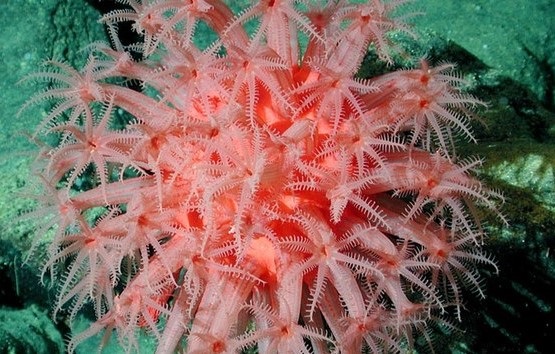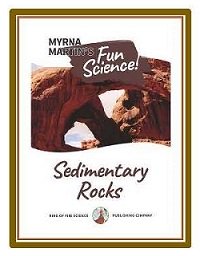plants & animals create ORGANIC ROCKS
Organic rocks formation
Remains of once living plants and animals
All organic rocks are formed from
the remains of once living plants and animals. Plants and animals produce
limestone from calcium carbonate (calcite). They create shells by extracting the calcium
carbonate from seawater. They create shells for protection by extracting the calcium carbonate from seawater and turning it into limestone shells.

Deep-water Mushroom Coral NOAA
Chalk Formation
White Cliffs of Dover
Chalk is a well-known rock that has been used by people for
centuries. The White Cliffs of Dover are a familiar landmark made of chalk. The
chalk cliffs were created by microscopic algae, coccolithophores,
that lived during the Cretaceous period.
Chalk forming plankton
Coccolithophores are microscopic marine algae that
create spherical skeletons called cocospheres. They are the most important
group of chalk forming plankton in the oceans.
Skeletons of microscopic marine algae become chalk
The cocospheres break apart and fall to the ocean floor
where it collects in sedimentary layers when the algae die. Lime mud forms from
the broken cocospheres and mud.
The lime mud is subjected to heat and pressure which removes the water and compacts the sediment. into chalk. Chalk forms when lime mud accumulates in some areas of the seafloor.
Formation of Diatomaceous Earth
Diatomaceous Earth
Diatoms are minute sea creatures similar to foraminifera. They extract silica, quartz, from ocean water to build their tiny shells. When these microscopic creatures die their shells drift down forming layers of silica ooze.The silica ooze compacts to form diatomite, a soft light-colored rock. Diatomaceous Earth is made from diatomite and is used to filter water.
DE is fossilized remains of diatoms
Diatomaceous earth (DE) is made from the
fossilized remains of diatoms. Diatoms are tiny sea creatures like
foraminifera. They extract silica (quartz) from ocean water to build their tiny
shells. When these microscopic plants die and their shells drift down forming
layers of silica on the seafloor. The silica layers compact to form diatomite.
Diatomaceous earth is white, crumbly, and made of quartz.


Click for More Information and to Order
Shallow & Deep water corals
Size of coral polyps
Corals are found in both shallow and deep water and
live in all of the oceans on our planet. Individual coral polyps are very
small. They are usually about the size of a pencil eraser. The largest polyps
are mushroom corals that grow about 12 cm in diameter.
Cnidarians all have stinging tentacles
Corals, sea anemones and
jellyfish look very different, but they are related. They all belong to the
group cnidarians (nid-air-e-ans) because they have stinging tentacles.
Structure of corals
Coral polyp structure
Corals have a simple polyp structure just like sea anemones.
Their bodies are like tin cans that are open at one end. The open end is the
mouth of the coral. A ring of tentacles surrounds the mouth.
The tentacles all have stinging cells called nematocysts. The nematocysts are used to capture prey as they swim near the coral. The coral captures the prey and moves the food inside their polyp where the tissues digest the food.
How coral reef begin to form in shallow water
Coral reef begin to form when tiny polyps settle on a rocky floor of the ocean. They are smaller than the eraser on a pencil. They extract calcite from ocean water to form their homes of limestone. The limestone protects them from predators.
Coral reefs are made up of colonies of corals. They grow in shallow water close to the shore of continents and small islands. Fringe reefs grow alongside the shore of a continental land mass.
Enlarging the coral reef
Each generation of polyp builds on top and enlarges the coral reef as they build their homes. The Great Barrier Reef in Australia is so large that astronauts can see it from space.
Coal formation in swamps
Swampy areas in warm climates
Coal forms in swampy areas in warm climates that are slowly sinking over long periods of time. Leaves and other vegetable matter falls into the water where it is covered up. Each fall a layer of silt is brought into the swamp after a rainstorm covering the plant material.
Formation of Peat and Coal
Coal is a sedimentary rock
Coal is a sedimentary rock that burns. It contains more than
50% decomposed plant material. Coal forms when plant material is deposited in
bogs or swamps in temperate climates.
All freshwater plants and stagnant water plants can form
coal. Biologists have identified over 3000 species of plants in coal. As plants
die and fall to the ground, microorganisms begin the process of
decay.
Peat
Floods bring in layers of silt that covers the layers of
vegetable matter. The silt cover combined with low oxygen content in the water
keeps some of the plant material from decaying. The layers at the bottom begin
to compress and gases are forced out of the vegetable matter. As the gases are
driven out, the carbon content of the rock increases.
A layer of peat 50 meters thick compresses until it is only 10 meters thick when it converts into lignite coal. Dried peat and coal are burned for fuel in many parts of the world.
KIDS FUN Science Bookstore
Check out Myrna Martin's award winning textbooks, e-books, videos and rock sets. The Kids Fun Science Bookstore covers a wide range of earth science topics. Click here to browse.










